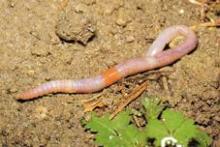living soil
The upper layer of the earth's crust is the living space for a variety of organisms.
One gramme of soil contains milliards of micro-organisms, i.e. bacteria, fungi, algae and protozoa, and below one square metre of soil there live hundreds of thousands up to millions of soil animals, such as threadworms, earth worms, mites, isopods, springtails and insect larvae. Reckoned on the basis of one hectare, this amounts to 15 tons of living weight, which corresponds to about 20 cows. There live considerably more organisms there than upon the soil.
These organisms are adapted to the conditions prevailing in the soils. Life in the soil is only possible in hollow space, which is filled with water or air. Small organisms rely on existing pores, larger ones dig their own holes. The soil organisms form close living communities, the composition of which depends on the qualities of the soil and of its use. For instance, in sour soils there are more fungi, whilst in neutral soils bacteria dominate, and soil with grassland utilization contain more organisms than fields.
In a complicated chain of food bacteria, fungi and soil organisms decompose organic substances and create new substances. Worms, isopods, mites, springtails and insect larvae break up the mulch - e.g. leaves or straw - and mix the material with the soil. Thereby they loosen the soil, they form stable crumbs of earth, they further aeration and increase the capacity to retain water. Earth worms, for instance, move up to twelve kilogrammes of earth per year in one square metre of soil. The actual decomposition of the mulch is effected by the bacteria and fungi of the soil. The largest part of organic substances is transformed, by a gain of energy, into carbon dioxide and water. The rest turns into the humic material. These dark substances improve the capacity of the soil to retain water and increase its capacity to store nutriments and pollutants.
They stabilize the soil aggregates and further the heating of the soil. When the mulch is decomposed, also the nutriments bound to the plant material are transformed into simple anorganic compounds, which can again be absorbed by the roots. The decomposition of mulch is therefore one of the most important achievements of the soil organisms.
The speed of decomposing mulch depends on the climate, on the type of vegetation and the qualities of the soils. In central European forests, five to seven tons of mulch accumulate per hectare and year.
Under favorable conditions, the soil organisms nearly completely decompose this quantity.
If the conditions are not favorable, however, such as in low-nutriment soils below coniferous forest, the decomposition of organic material is effected more slowly. The consequence is that up to some decimetres of mulch layers are formed.
Beside the mulch, the micro-organisms of the soil are also able to decompose organic pollutants, such as e.g. mineral oils and pesticides. This capacity is also known as the self-purification capacity of the soils and used for their rehabilitation.
Apart from this, some micro-organisms have the capacity to transform nitrogen from the air into organic nitrogen compounds. For instance, nodule bacteria of the genus rhizobia, which live in a symbiosis with plants of the pea family, such as clover, bean or lucerne, bind more than 300 kilogrammes of nitrogen per hectare and year. As a comparison:
Wheat withdraws from the soil per hectare and year about 150 kilogrammes of nitrogen. The ecological cultivation can therefore by a purposeful cultivation of plants of the pea family completely refrain from using nitrogen-enriched mineral fertilizers.
A very close relation also exists between fungi of the soil and more sophisticated plants, which is partly already expressed in the designation of the fungi (e.g. shaggy boletus). This symbiosis is called mykorrhiza. Thereby, the fungi form a further netting at the rooting of the plants and thereby increase the area of contact with the soil. On account of their small diamter they penetrate into even finer pores of the soil and thus provide water and nutriments for the plants (especially phosphor).
26.09.2024
555 x Paradies-Genüsse - Obstvielfalt entdecken und schmecken
more ...24.+25.09.2024
31th Conferece of the Danube Region
more ...21.09.2024
Fest der Obstvielfalt im Alchemistenpark
more ...13.-15.09.2024
Mein Beeren- und Obstparadies
more ...11.-13.09.2024
Tropentag 2024
more ...06.-09.2024
ernte.dank.festival. am Wiener Heldenplatz
more ...15.+16.05.2024
Bodenforum Österreich - Frühjahrstreffen 2024
more ...20.-21.04.2024
Joel Salatin - Masterclass-Seminar Weidemanagement
more ...16.04.2024
Exkursion Mehrnutzungshecken
more ...12.04.2024
Dialog Zukunft Pflanzenbau: Runder Tisch - EU Richtlinie zur Bodenüberwachung und -resilienz
more ...12.04.2024
Online-Workshop Boden und Klima - Ganzheitliches Wassermanagement in Stadt und Land
more ...03.04., 04.04., 23.04.2024
Flexibles Begrünungsmanagement im Wein- und Obstbau
more ...27.-29.03.2024
Mein Beeren- und Obstparadies
more ...20.03., 21.03., 03.04., 04.04., 23.04.2024
Flexibles Begrünungsmanagement im Wein- und Obstbau
more ...20.03.2024
Obstbaumschnittkurs für langlebige und gesunde Bäume "Stummelschnitt ade"
more ...12.-14.03.2024
Vortrag: "Die Essbare Stadt, Geeignete Obstbaumarten für den Urbanen Raum"
more ...13.03.2024
Carbon Farming, wofür und für wen? - Hybridveranstaltung
more ...12.03.2024
Zertifikatslehrgang Bodenpraktiker Ackerbau 2024
more ...09.03.2024
Stummelschnitt ade - Obstbaumschnittkurs für langlebige und gesunde Obstbäume
more ...05.03.2024
Exkursion Mehrnutzungshecken
more ...



